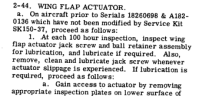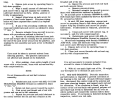Gary Ward
En-Route
My wife and I flew it 1.9 hours today. XC at 55 and 6500 under the clouds. She is such a test co pilot! Lol
Never seen this done before. Really strange to see people doing this.This a flap actuator I took out of a Cessna R172K (Hawk XP). It is typical of mechanics who do their own thing.
View attachment 123176
The mechanics had been using the moly grease that was not applicable to this actuator; the grease is intended for the plain-screw actuators.
View attachment 123177
The microswitch was full of it. That round collar below the switch is the recirculating-ball nut. The balls run in semicircular grooves in the screw.
Even the electrical connectors were greasy.
View attachment 123178
Even the down-limit switch had grease on and in it, carried there by the travelling nut.
View attachment 123179
It took a long time to get the grease out of everything, especially that ball nut. Replaced connectors, and I think I may have used new switches, too, to be safe. Hard to get all that stuff out of them.
View attachment 123180
Now, if the mechanics had taken the ten minutes to read the section on jackscrew lubricating, this owner wouldn't have had to pay for a lot of shop time to correct it all.
OK, I don't own no 172 and ain't never likely to even work on one, but I do appreciate you posting your progress with the pictures - I find this type of content very interesting.My wife and I flew it 1.9 hours today. XC at 55 and 6500 under the clouds. She is such a test co pilot! Lol
Strange to see people doing what? Screwing things up? Or fixing the screwed-up things? Neither are uncommon at all.Never seen this done before. Really strange to see people doing this.
Never seen people lube flap actuator threads.Strange to see people doing what? Screwing things up? Or fixing the screwed-up things? Neither are uncommon at all.
Never seen people lube flap actuator threads.
Of course not. Many shops seem to do the absolute minimum, and that's where problems start. Once the problem gets too big to ignore, it has become an awfully expensive thing to fix, much more than if the manufacturer's recommendations were followed.Never seen people lube flap actuator threads.


Ah okay I see. I didn't notice there was a serial number range for the procedure. I've only ever touched a few 182s. I see your second point and yeah it seems people got into a routine without verifying.Of course not. Many shops seem to do the absolute minimum, and that's where problems start. Once the problem gets too big to ignore, it has become an awfully expensive thing to fix, much more than if the manufacturer's recommendations were followed.
From a Cessna 182 manual:
View attachment 124203
View attachment 124204
Note the different lube treatments for different serial numbers or of airplanes with flap actuator modifications. That greased-up mess I posted was from a later-model airplane that should have just been lightly oiled.
I try to make it interesting and I learn from everyone here. Thank you.OK, I don't own no 172 and ain't never likely to even work on one, but I do appreciate you posting your progress with the pictures - I find this type of content very interesting.
Thanks.
I got it back together after work today. The flaps operate correctly and very quiet and smooth. We'll see how long they last before needing some lube?
The aft rollers and washers are a little easier to get lined up and the bolt in. Tough as hell tightening the nut while holding a 1/4" rachet in my other hand backing up the bolt head. I did it solo again tonight. You know, if there is a will...
Extra set of hands would be less stressful.

All 4 forward rollers got stainless washers on the sides to protect the arms of the flap. The side washers bolt in solid with the inner race of the bearing so the only thing that turns is the roller outer race. SEB95-3

Only the inner aft rollers used a mcfarlane STC that has side washers build into the original width and they also bolt in tight with the inner race of the roller. Should eliminate any wear on the flap and arms and hopefully the tracks which was the most important thing to me. Cause replacing those are not easy or fun.


The outer aft rollers were not modified, got new roller bearings with the same combo of original spacer and new stainless washers that was on the original roller. It sets the side play.

Now lets get back to flying when the weather gets better. Thanks for every ones help.

Thank you.Your posts and photos have been informative and entertaining. Thanks for sharing.
Well, now. I see a gear strut fairing, fiberglass, to replace the cracked plastic one. I see two new ground straps, for the battery and engine. I see a McFarlane nosegear torque link bushing kit.Guess what is next...
Totally agree with Dan^^^^Now, another question arises: are the torque links being rebuilt because the nosewheel shimmies?
One can spend a lot of money and time chasing nosewheel shimmy. Torque links, shimmy damper rebuilds, static balance of the nosewheel assembly. As I have been preaching here for many years, the root cause is dynamic imbalance of the nosewheel. Yes, one can mask the shimmy by fooling with all the other stuff, but it's treating symptoms instead of the disease. If one leaves the wheel imbalanced, it just beats up the new parts and the shimmy returns.
See this old post:
https://www.pilotsofamerica.com/com...-missing-from-many-c182s.123329/#post-2847848
Try taking it to a motorcycle shop that has a dynamic balancer. Another POAer did that and was happy with the result. But take the seals and bearings out of it first, or they might just mount it with the balancer cones in the seals. That will have the wheel off-center, and the balancing won't turn out well.I will check the static balance of the front tire and rim when I take it off the fork.
Before that I will check the tire for out of round before I take it off. If any of that indicates a junk tire it will get replaced. Like you said, don't want to beat up new parts.
